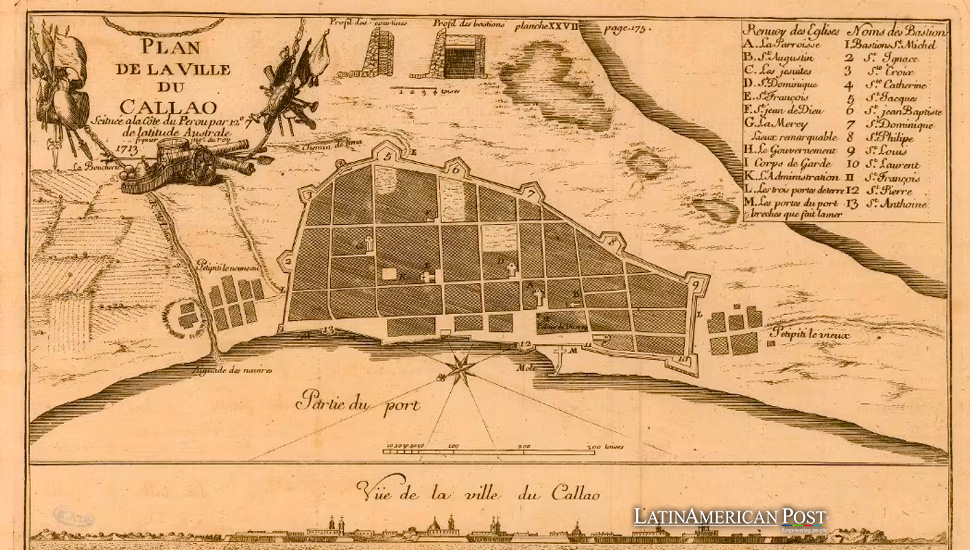Unearthing Colonial Life Through New Discoveries at Peru’s Real Felipe Fortress

Peruvian archaeologists have unearthed colonial-era artifacts at the Real Felipe Fortress in Callao, the most prominent Spanish fortress in America, shedding light on the region’s historical past.
Unveiling Peru’s Colonial Past at Real Felipe Fortress
In the historic heart of Callao, Peru, a team of dedicated archaeologists has made groundbreaking discoveries at the Real Felipe Fortress, unveiling artifacts that offer a glimpse into the colonial life that once thrived in the most prominent Spanish fortress built in America. This recent find, announced by official sources this Wednesday, marks a significant milestone in exploring and understanding Peru’s rich colonial history.
The discoveries, part of the ‘Archaeological Research and Conservation Project of the Real Felipe Fortress and Monumental Zone of Callao (PIA),’ were detailed in a press release by the Ministry of Culture. The unearthed items include a collection of bottles, glass pieces, and fragments of decorated pottery from the colonial period. These artifacts, now brought to light, provide invaluable insights into the daily lives, customs, and aesthetic preferences of those who once inhabited the fortress and its surroundings.
Gianella Pacheco Neyra, the archaeologist leading the project, cited in the ministry’s announcement, revealed that among the findings was a brick floor that likely belonged to a patio or cloister predating the fortress’s construction. This discovery is fascinating as it suggests the presence of structures and activities that predate the fortress itself, offering clues to the area’s use and significance before the fortress was erected.
Construction and Significance of Real Felipe Fortress
The construction of the Real Felipe Fortress commenced in 1746 following a devastating earthquake and subsequent tsunami that destroyed the existing fortification. This catastrophe leveled the previous defense structures and prompted a reevaluation of the strategic importance of protecting the port of Callao, leading to the construction of the formidable Real Felipe Fortress.
The PIA project plans to excavate a total of 16 test pits, expecting to uncover further artifacts that will enrich the narrative of ancient Callao. This ambitious undertaking aims not only to recover physical objects but also to piece together the historical puzzle of the region, illuminating the complexities of colonial life and the architectural evolution of the fortress.
César Benavides, head of the Decentralized Directorate of Culture of Callao, expressed his satisfaction with the local government’s commitment to heritage conservation. “It’s gratifying to know that local governments still value their heritage,” he stated. Benavides emphasized the importance of understanding history and culture, not just for preserving the past but as a means of informing the present and shaping a better future for the residents of Callao.
The significance of these discoveries extends beyond the academic community; it touches the hearts and minds of the local population and visitors alike. By delving into the past, the project helps to forge a connection between the present-day residents of Callao and their ancestral roots, fostering a sense of pride and belonging. Furthermore, these findings contribute to the broader narrative of Peru’s colonial history, offering fresh perspectives on the cultural and social dynamics of the era.
From Military Structure to Living Museum
The Real Felipe Fortress, with its imposing walls and strategic location, has long been a symbol of Spanish colonial power in the Americas. However, the recent archaeological finds add layers of depth to our understanding of the site, transforming it from a mere military structure into a living museum of colonial life. As the PIA project continues, each artifact unearthed is a testament to the rich tapestry of human history that the fortress has witnessed.
These discoveries at the Real Felipe Fortress are a reminder of the importance of preserving cultural heritage. They highlight the ongoing dialogue between the past and the present, demonstrating how historical sites can catalyze cultural understanding and community development. As the project progresses, more light will be shed on the mysteries of colonial Callao, offering new insights into the lives of those who walked its streets, defended its port, and called it home.
Also read: Mexico Recovers 30 Archaeological Pieces from Los Angeles, Strengthening Cultural Heritage
The archaeological work at the Real Felipe Fortress is more than just an excavation; it is a journey back in time, uncovering the stories of those who lived, worked, and perhaps even fought within its walls. As these stories are pieced together, they enrich our understanding of Peru’s colonial past and inspire us to reflect on the legacy we wish to leave for future generations. Through the dedicated efforts of archaeologists, historians, and local officials, the Real Felipe Fortress stands as a beacon of cultural memory, inviting us all to explore the depths of our shared heritage.




